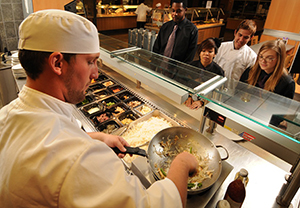Think Tank: Partners in Education
Tuesday, 07 October 2014 12:58
 Integration of industry and education better prepares students for success and makes a school essential in the eyes of all stakeholders. Good news is that opportunities for your program to partner with your local business community are endless.
Integration of industry and education better prepares students for success and makes a school essential in the eyes of all stakeholders. Good news is that opportunities for your program to partner with your local business community are endless.
By Paul Sorgule, MS, AAC
Sometimes programs tend to underestimate the breadth of resources and educational talent at their disposal. We look to our full- and part-time faculty as the primary resource and strength of a program, as one would assume.
However, those program administrators who see the potential to draw the hospitality community into the folds of their faculty resources can build a truly dynamic curriculum to rival the largest and finest colleges. Creating a stage for Partners in Education allows business leaders to understand how they might assist in building extraordinary opportunities for young people aspiring to a career in hospitality.
We all understand how this might occur through internships and externships, giving students the ability to apply the hands-on skills they are developing in a campus program, but few programs understand that this “partnership” can extend to all academic courses, as well. Hands-on can apply to every part of your curriculum. Considering that most students enrolled in culinary programs are tactile learners, this application approach can result in a more-engaged student, enhanced relationships with outside stakeholders in your program, and a truly balanced graduate.
Students, parents and accrediting agencies are collectively holding college administrators and faculty members to a different standard. Everyone seems to want measureable, and visible, outcomes that make a difference in a student’s professional life. Stakeholders are looking for value.

 New research from the National Restaurant Association shows a substantial number of operators are implementing sustainability best practices into their businesses.
New research from the National Restaurant Association shows a substantial number of operators are implementing sustainability best practices into their businesses. True tastes of the bayou are surfacing throughout the South, and
True tastes of the bayou are surfacing throughout the South, and  In this final of three installments focusing on employing an effective interaction strategy to increase loyalty and sales in your program’s student-run foodservice outlets, influencing four customer perceptions—“Fresh,” “Trust,” “Mystery” and “Ownership”—is key to success.
In this final of three installments focusing on employing an effective interaction strategy to increase loyalty and sales in your program’s student-run foodservice outlets, influencing four customer perceptions—“Fresh,” “Trust,” “Mystery” and “Ownership”—is key to success.